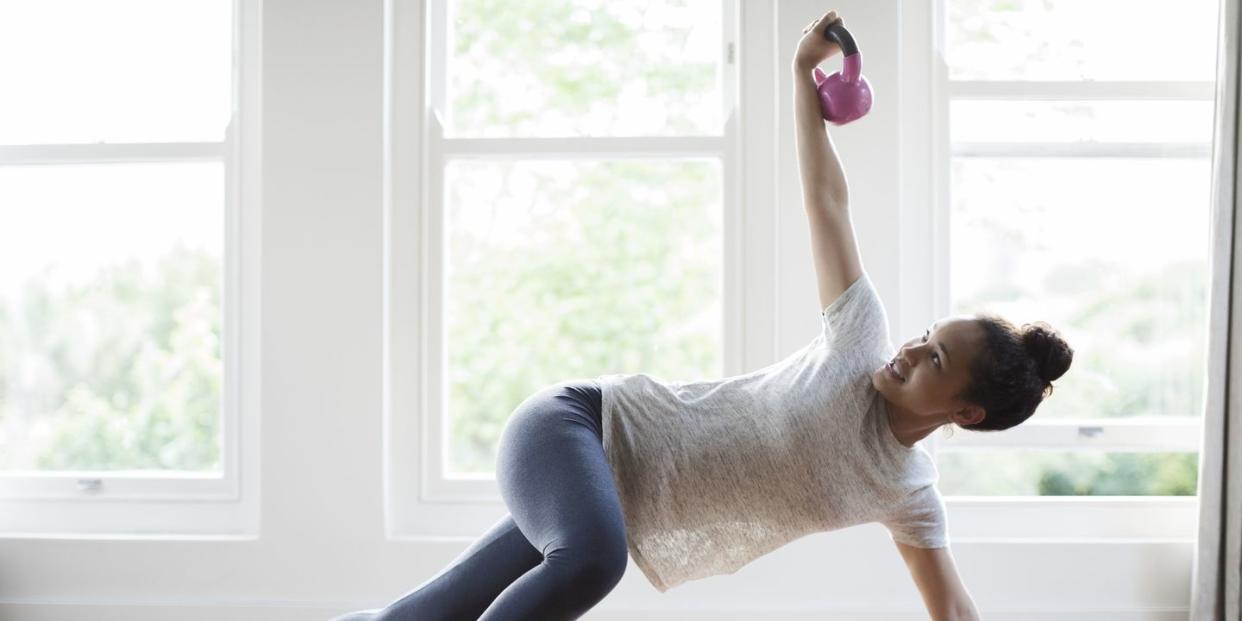A beginner’s guide to weight training

Weight training, also known as strength training or resistance training, is beneficial for everyone, especially as we get older. It strengthens your muscles and bones, improves your posture and mobility, enhances your sports performance and helps protect you from injury.
The NHS recommends that adults should aim to do strengthening activities, such as lifting weights, working with resistance bands or bodyweight exercises, at least twice a week. When we turn 30, we start to lose muscle mass – as much as 3 to 5 per cent per decade – while our metabolism simultaneously begins slowing down. However, regular strength training can work to counteract this and help to keep age-related weight gain at bay.
Michelle Njagi, senior MSK physiotherapist at Bupa Health Clinics, run us through the benefits of weight training and how to get started.
What is weight training?
Weight training is a form of strength exercise, which involves moving your muscles against a form of resistance. Weight training puts stress on the muscle being trained, causing your muscle to adapt and become stronger. However, weight training can leave the muscles feeling fatigued, so make sure you allow your muscles time to recover after each workout. This will help improve your overall performance and replenish your body’s energy stores.
Does weight training burn fat?
Weight training requires high levels of energy consumption and, because of this, weight training helps burn fat; the more muscles worked during a workout the more fat is burned. While weight training burns fat, it also helps build muscle at the same time.
How many calories does weight training burn?
There is no set amount of calories weight training can burn, as each session will be different. However, the more muscles you work during a session the more calories will be burned. Full body workouts are great for a maximum calorie burn. If you are interested in tracking your calories during a workout, you can track these through a wearable device, on an app or using Bupa’s calorie calculator, which will give you a rough estimate of the calories burned for your workout.
Benefits of weight training
Improves strength
Weight lifting improves bone density and may help to prevent osteoporosis by facilitating bone growth, according to the University of Missouri-Columbia.
It is also great for improving the strength of your muscles, promoting good posture and balance. When your muscles are stronger, they also work more efficiently and reduce injury risk through overload.
Maintains your weight
Using all your muscles helps to burn calories. Weight training is great for helping you maintain a healthy weight when it’s part of a balanced lifestyle. Scientists at Boston University found that increased muscle mass can improve metabolic parameters such as insulin resistance, which can also help with weight regulation.
Aids memory
Weight training for as little as 20 minutes can enhance long-term memory by about 10 per cent, research from the Georgia Institute of Technology revealed.
Regulates blood pressure levels
While your blood pressure can increase during a weight-training session, the overall benefits of weight training can outweigh the temporary increase in your blood pressure and can be a good way to keep blood pressure levels under control. However, be careful if you suffer from a high blood pressure, and make sure you consult an expert – like a physiotherapist – before you begin.
Boosts your mood
Weight-based exercises can help boost your mood and are a great way to take a step away from the stresses of life. However, weight training is not the only form of exercise to help boost your wellbeing. If weight training isn’t for you, any type of frequent exercise can help increase your mood levels. Why not try interval training, or swap for a cardio-based activity, such as running or swimming?
Improves your lifestyle
Another lifestyle benefit of weight training is the positive impact it can have on your ability to do everyday activities. From something as simple from opening a stiff jar or carrying heavy bags, there are some surprising benefits to lifting those weights.
Supports heart health
Lifting weights for less than an hour a week may reduce your risk of a heart attack or stroke by 40 to 70 per cent, according to a study by Iowa State University.

Men vs. women
Weight training helps to build up your muscles and increase strength in both men and women. Hormone differences between men and women can mean it affects each gender differently - for example, men often tend to build a higher muscle mass than women when weight training regularly. It is a common myth that many women believe weight training will cause them to become too ‘muscly’. Weight training builds a strong foundation which is advantageous as we begin to age.
Getting started
Start slow, and build up gradually
Two-to-three weight training sessions per week will be enough to help you to start building muscle. Aim to start with lighter weights and lower repetitions; as your muscles gradually get use to the stress exerted on them during a workout you can begin to increase the weights used to challenge yourself. However, be careful to not to push yourself too much as this can cause an injury.
Master that technique
It is important you master the right technique from the beginning when weight training; the better your form the better the results you will see. If you are unable to maintain a good form, it’s probably a sign the weight you are using is too heavy – remember to start light and gradually build up your weight. Standing in front of the mirror can help make you more aware of your body position when first starting.
Allow your body to rest
Allow your muscles to rest after each session as this helps prevent injury and fatigue by allowing the body to recover its energy stores. If you’re working out two-to-three times a week, allow for rest days in-between full body workouts. However, if you would prefer to work out daily, try to alternate the muscles you work each day. For example, one day you could focus on your arms and the next on your legs.
Here’s a few examples of some weighted exercises to start with using dumbbells:
• Squat presses
Start with your feet hip-width distance apart and your hands in front of your chest. Slowly lower yourself into a squat position, pushing back into your heels and making sure your kneed are in line with your toes. As you come back up raise your arms above your head and return to your starting position.
• Bicep Curls
Stand up straight with your arms by your side. Keeping your elbows in close, raise your arms up and in towards your biceps, and lower.
• Tricep extensions
Hold one dumbbell in both hands above your head and gently lower your hands towards the back of your neck. Keep your elbows in tight beside your head and your back straight. Then raise your hands back up above your head.
• Bent over dumbbell row
Start with your knees bent and hinge forward from your hips. Keeping your back straight let your arms hang in front of you and then pull them towards you, squeezing your back muscles and keeping your elbows close.
Weight training beginner’s workout
It can be difficult knowing which workout to follow if you’re new to exercise. Here we share a beginner’s workout for you to try, which can be completed either at home or at the gym. You should add the above weighted exercises into this workout and aim to complete each exercise two-to-three times with 12 repetitions each.
• Warm up
It is important to get your muscles loosened and ready for exercise. This doesn’t have to be an intense exercise, simply jog on the spot for three minutes, as this will get your heart rate up.
• Squat presses
Start with your feet hip-width distance apart and your hands in front of your chest. Slowly lower yourself into a squat position, pushing back into your heels and making sure your knees are in line with your toes. As you come back up, raise your arms above your head and return to your starting position.
• Bicep Curls
Stand up straight with your arms by your side. Keeping your elbows in close, raise your arms up and in towards your biceps, and lower.
• Tricep Extensions
Hold one dumbbell in both hands above your head and gently lower your hands towards the back of your neck. Keep your elbows in tight beside your head and your back straight. Then raise your hands back up above your head.
• Bent over dumbbell row
Start with your knees bent and hinge forward from your hips. Keeping your back straight let your arms hang in front of you and then pull them towards you, squeezing your back muscles and keeping your elbows close.
Additional exercises to include could be:
• Lunges
For this exercise you can use dumbbells in each hand or use your body weight.
Stepping forward with your right leg, bend both knees, lowering your left knee to the floor, making sure your knee doesn’t come further forward than your toe line. Bring your right leg back to your starting position and repeat on your left side.
• Chest Press
Lie on a bench with your elbows bent at 90 degrees and out to the side, straighten your arms up and above your chest and return to your starting position.
• Cool down
End your workout by bringing your heart rate down and stretching out the muscles you have just worked. This will help boost your recovery.

Weight-training tips
Certified personal trainer Joel Freeman, creator of online strength training programme LIIFT4, suggests the following tips for establishing an effective and safe weight-training routine at home:
Do: focus on form
It’s a cliche, but prioritise quality reps over quantity. "Proper form is key to avoiding injury," says Freeman. "If you’re new to weight training, it’s worth investing in a personal trainer at your gym or following a home programme." When lifting a weight, use a tempo of 1:3. Take a second to lift, pause at the top of the movement, and take a full three seconds to return to the starting position.
Don’t: overtrain
Two weight-training sessions per week are a good starting point. As you progress, you may wish to train more frequently – but always make time for rest and recovery. "I take one full rest day every week," says Freeman. "Then I feel good and rested coming into the next week of training."
Do: warm up
Get your body moving first. This helps to improve your range of motion, so you can get the most from each exercise, and reduces the risk of injury.
Don’t: neglect cardio
"Cardio exercise helps with your heart’s overall performance and efficiency, increases your lung capacity, and burns calories to assist in fat loss, which all help prevent diseases and illnesses like heart attack, high blood pressure, diabetes and high cholesterol," says Freeman.
Do: stretch
Do this immediately after your workout ends. "The more you lift weights, the more you need to stretch," says Freeman. "Taking five to 10 minutes after every workout session will do wonders for the way your muscles recover as you continue to train."
Don’t: repeat the same routine
Tweak your workout every six weeks to avoid hitting a plateau. You could change the exercises, the number of sets and reps, the rest period, the equipment you use, the tempo.
Do: remember to breathe
It’s easy to hold your breath when concentrating, but your muscles need oxygen to create fuel. Most exercises benefit from an exhale when you lift the weight and an inhale when you lower it. Breathe through your mouth rather than your nose.
In need of some at-home inspiration? Sign up to our free weekly newsletter for skincare and self-care, the latest cultural hits to read and download, and the little luxuries that make staying in so much more satisfying.
Last updated: 22-09-2020
You Might Also Like


